Choosing the Right Brush for Liquid Foundation


Intro
Choosing the right brush for liquid foundation can feel like navigating a minefield, especially with the dizzying array of options available today. It's not just about the bristles or handle; it's a blend of materials, shapes, and sizes that can dramatically alter your makeup routine. Getting this step right can make the difference between looking immaculate and feeling like you've tried to paint with a shovel.
In recent years, the beauty industry has seen shifts akin to trends in fashion—always evolving and drawing influence from culture and social media. Understanding what's on trend can empower you to make informed decisions. Not to forget, factors such as sustainability are becoming increasingly relevant as consumers become more conscientious about their purchases.
So, how do you sift through the noise to find the ideal brush? This article lays out a comprehensive guide, covering essential aspects of brush selection, the impact of different materials, and expert techniques that will elevate your foundation application. By the end, you’ll have a firm grasp of how to choose a brush that not only meets your needs but enhances your overall beauty regimen.
Understanding Liquid Foundation
Navigating the world of liquid foundation is like finding your way through a maze; one wrong turn, and you could end up lost in a sea of options that might not really suit your needs. To master the application process, it’s essential to understand what liquid foundation is and the various formulations available. Not only does this understanding inform the type of brush to select, but it also enhances the overall outcome of your makeup application, ensuring that you achieve a look that feels and looks polished.
Defining Liquid Foundation
Liquid foundation serves as a cosmetic solution designed to create an even base for your makeup. This versatile product is often favored due to its ability to provide varying levels of coverage, making it suitable for different skin types and occasions. Liquid foundations typically come in a bottle or tube, and their fluid nature allows them to blend seamlessly into the skin. When applied with the right brush, they can create a flawless finish that enhances your natural beauty without appearing cakey or overdone.
Different Formulations Available
Liquid foundations don’t come in a ‘one-size-fits-all’ variety. Rather, they come with a range of formulations, each delivering unique characteristics that cater to a variety of skin types and desired effects. Here, we’ll explore five prominent formulations that you’ll encounter in this beauty landscape, helping you to make an informed selection.
Matte
Matte liquid foundation is renowned for its ability to control shine, making it a go-to choice for those with oily or combination skin. The key characteristic of matte formulations is their oil-absorbing properties which reduce excess oil and create a velvety finish. This type of foundation often includes ingredients like clay or silica, which can absorb oil and provide a long-lasting effect without slipping.
However, it's worth noting that matte foundations can sometimes appear flat on the skin, lacking the luminosity that some might desire. It’s a beneficial option if you aim for a polished look that holds up under pressure, especially in warmer climates or during long days.
Hydrating
On the flip side, hydrating liquid foundation has become increasingly popular for its skin-loving ingredients. Enriched with moisturizers and extracts such as hyaluronic acid, these foundations cater especially to those with dry or mature skin. The primary characteristic of hydrating formulas is their ability to provide a dewy, luminous finish, leaving the skin looking fresh and well-moisturized.
These formulations can help to plump and smooth out skin texture, making imperfections less noticeable. Though they provide a beautiful glow, a downside may be their staying power—if you’re in a humid environment, you might find that it requires touch-ups throughout the day.
Full-Coverage
Full-coverage liquid foundations aim for a no-holds-barred approach to concealing imperfections. Their thick consistency and high pigmentation allow them to effectively cover blemishes, redness, or uneven skin tone. The distinctive characteristic of this formulation is its ability to provide a dramatic finish, which can be a double-edged sword.
While it delivers excellent coverage, full-coverage foundations can sometimes feel heavy on the skin or appear mask-like if not blended appropriately. They are ideal for special occasions like weddings or photoshoots where you want your makeup to last and look flawless.
Sheer
In contrast to its full-coverage counterpart, sheer liquid foundation offers a lightweight option that’s ideal for those who prefer a more natural look. This formulation is characterized by its ability to even out skin tone without masking your natural features. The sheer coverage allows your skin to breathe, making it suitable for everyday wear.
It’s a great choice for someone aiming for a barely-there feel, but keep in mind that those seeking to cover significant blemishes may not find it as effective. Ultimately, sheer foundations shine in their ability to deliver a fresh-faced appearance, adding just enough tint to enhance your complexion.
Long-Wear
Lastly, long-wear liquid foundations come into play when the goal is durability. These formulations are designed to resist fading and transfer, which is particularly useful for busy days or events. What sets long-wear foundations apart is their specialized technology that helps them adhere to the skin for hours on end.
While these foundations can be a boon for longevity, they might require a bit more effort during removal, as they can cling stubbornly to the skin. However, the trade-off may be worth it for that confidence boost of knowing your makeup looks flawless from dawn till dusk.
Importance of Brush Selection

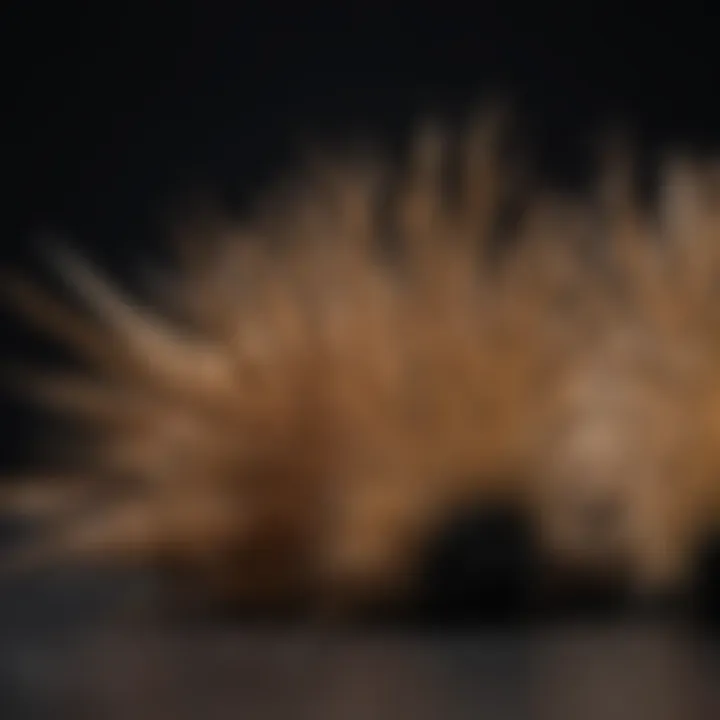
Selecting the right brush for liquid foundation application is not just about looking good; it’s about achieving quality results that endure through the day. The right brush can elevate your makeup game, enhancing the finish and wear of your foundation, while the wrong one can lead to uneven texture and an unflattering look. Knowing the significance of brush selection goes beyond mere aesthetics; it touches on issues of practicality, comfort, and overall efficacy.
A key aspect to consider is application quality. When a foundation brush is tailored for liquid formulations, it ensures even distribution across your skin, minimizing streaks and patches. For instance, a densely packed brush helps to build coverage without caking, while a softer, fluffier brush may offer a sheer, natural finish. The importance of having these tools at your disposal can't be overstated.
Moreover, think about the features of a good brush. An effective brush must possess durable bristles that won't shed or fray with regular use. You don't want to end up with bristles on your face while you try to achieve that flawless look. The handle design is also pivotal; it should fit comfortably in your hand to allow for controlled, precise movement, making your makeup application smoother and less of a chore. Choosing a brush that feels right in your grip can make all the difference, especially during longer application sessions.
In addition to these practical factors, there's a psychological element to brush selection that shouldn't be ignored. When you invest your time and resources in the right tools, it sends a message to yourself that you value the process of getting ready. Feeling confident with your brush can translate into the self-assuredness that shows on your face. This trifecta of quality application, thoughtful design, and a boost in confidence makes understanding brush selection key to mastering liquid foundation application.
Impact on Application Quality
The foundation brush you choose has a direct effect on how well the product sits on your skin.
- Even Coverage: A well-designed brush spreads foundation seamlessly, allowing for a more even coverage. No one wants a patchy complexion.
- Blendability: Brushes, especially buffing and stippling kinds, help in blending the foundation into your skin, creating a second-skin effect.
- Control: Different brushes also offer varying degrees of control over your application. For instance, an angled brush can help define areas like the jawline, while a flat brush works well for larger sections like the forehead.
By understanding the impact your brush has on application quality, you empower yourself with the knowledge to make informed decisions at your beauty counter.
Brush Types vs. Sponge Techniques
When it comes to applying liquid foundation, many people grapple with the choice between brushes and sponges. Each offers its own merits, and the preference often boils down to personal technique. Let's break down the differences:
- Brushes: Generally, brushes are better for precise application. They allow you to layer product effectively and provide control over how much coverage you apply. Brushes can also facilitate a more polished, airbrushed look.
- Sponges: On the other hand, sponges—like the popular Beauty Blender—offer a more natural finish by soaking up excess product. They excel at blending, which can be great for those seeking a day-to-day, casual look. Sponges can also add hydration, especially when damp.
Ultimately, whether you prefer a brush or a sponge should align with your skin type and the finish you're aiming for. Some beauty enthusiasts even combine both techniques to leverage the benefits of each.
Understanding these considerations allows for better choices in selecting your foundation application tools. As you refine your makeup routine, each small detail contributes to that desired, flawless finish.
Types of Brushes for Liquid Foundation
When selecting the proper brush for liquid foundation, understanding the various types is paramount. Each style serves a distinct purpose, ensuring that the product is applied seamlessly for a polished appearance. Brushes can significantly affect the outcome of the foundation application; hence, knowing what each type brings to the table is invaluable for any makeup enthusiast.
Flat Foundation Brushes
Flat foundation brushes are indispensable for those who favor a more direct application. Typically, they feature a rectangular head with densely packed bristles. This design allows for a smooth surface coverage, perfect for achieving an even tone without streaks. With these brushes, one can easily reach tricky areas such as around the nose or along the jawline.
Consider this: if you have a more matte foundation, using a flat foundation brush can help deliver that precise finish you're after.
Buffing Brushes
Buffing brushes, also known as buffing foundation brushes, are ideal for blending liquid foundation into the skin. Their unique design features a rounded, densely packed head that allows for easy circular motions when applying product. This method gives a flawless, airbrushed look. Many users appreciate buffing brushes for their versatility; not only can they apply foundation, but they can also be used for concealers and powders.
For those who often work with full-coverage foundations, these brushes can be lifesavers in smoothing out the product while simultaneously ensuring that the skin looks like skin, rather than a mask.
Stippling Brushes
Stippling brushes are designed for those who want a light application with the ability to build coverage gradually. Characterized by their dual-bristle design—short and dense bristles combined with longer ones—stippling brushes allow for an airier finish. This type is especially notable for creating a soft, diffused effect that works wonderfully with more liquidy foundations.
Many makeup lovers enjoy the flexibility to switch between spot coverage and a sheerer application by just adjusting the pressure used during application. It's worth trying if you’re aiming for a naturally radiant look.
Rounded Brushes
Rounded brushes take a slightly different approach. With their dome-shaped heads, they excel at covering broader areas while still allowing for precision work around the eyes and nose. The round shape provides movement that mimics the natural curves of the face, offering a very flattering finish with less effort than some of the other brush types.
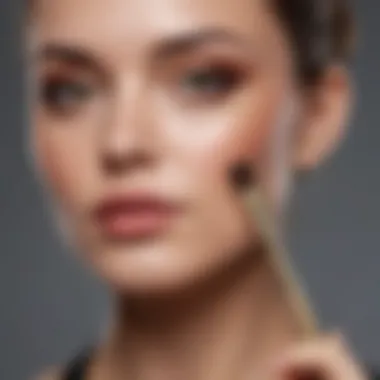
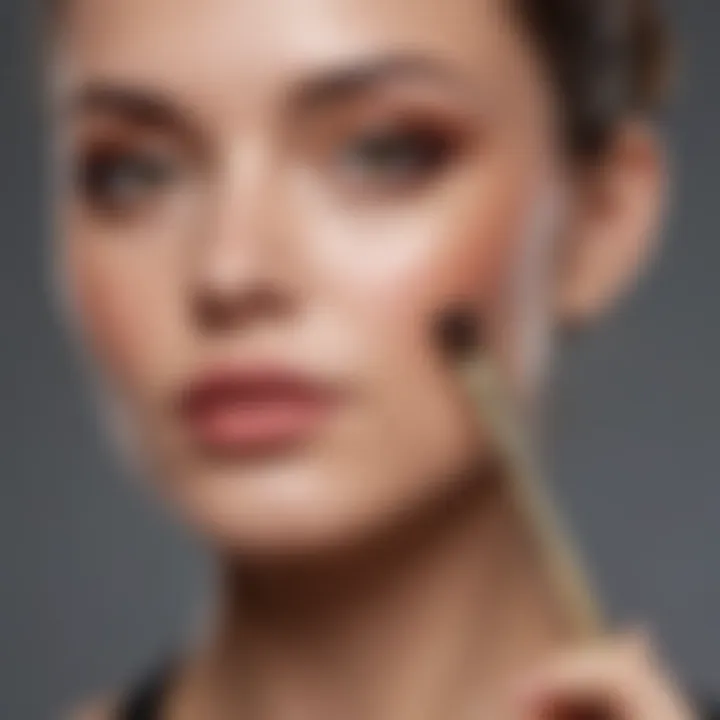
Users often find that rounded brushes work beautifully for cream foundations, allowing for easy buffing and blending to achieve a seamless look.
Angled Brushes
Angled brushes stand out with their slanted bristles, designed to cater to the contours of the face. This design can be particularly useful for applying foundation on the cheekbones and jawline. If one seeks to sculpt and define facial features, an angled brush is an excellent choice. Moreover, these brushes provide control and precision, making them particularly effective at layering product to meet desired coverage levels.
Choosing the right brush type for liquid foundation is essential for a flawless application. Each of these brushes brings unique benefits that cater to different styles and preferences. As you navigate your options, consider how each brush aligns with your desired outcome—be it a natural finish or full coverage, there’s a perfect brush type waiting to enhance your liquid foundation application.
Attributes of an Effective Foundation Brush
Selecting the right brush for liquid foundation isn't just a trivial matter; it speaks volumes about the precision and finish you can achieve. The right brush attributes ensure that application becomes not just easy but also enhances the overall quality of your makeup. From the type of bristles to the design of the handle, every detail contributes to the efficiency and experience of applying liquid foundation. These factors not only dictate how well your makeup adheres to your skin but also play a role in how long it lasts throughout the day. Let's delve into the specifics that make a foundation brush truly effective.
Quality of Bristles
Synthetic vs. Natural
Synthetic bristles, often made from materials like nylon or Taklon, are becoming quite a favorite among makeup enthusiasts for various reasons. They are typically smoother, make blending liquids a breeze, and do not absorb the product in the same way that natural hairs do. This means that more product goes on your skin rather than being soaked into the bristles. Furthermore, synthetic brushes are usually hypoallergenic, which is great for people with sensitive skin.
On the flip side, natural bristles usually come from animal hair, such as squirrel or goat, giving them a softer touch that many people adore. They can provide a butter-like application and work fantastically well with powder products. However, they may not deliver the same level of coverage with liquid foundations. There are always ethical concerns arising regarding animal hair, making synthetic brushes the more humane choice for many.
"Choosing between synthetic and natural bristles often reflects personal preference and ethical considerations."
Density and Softness
The density of the bristles plays a pivotal role as well. Denser brushes can hold more product, allowing for full coverage with a single application. This can be particularly beneficial when working with thicker liquid foundations that require more blending. With the softness of the bristles, you need to strike a balance. Too soft and they may not spread the foundation efficiently; too hard, and they may exacerbate skin irritation or leave brush strokes on your face.
It's remarkable how some brands manage to blend both density and softness into their brushes. A well-designed brush that mixes soft tips with dense volume can give you that coveted airbrushed finish without the need for extra layers. Many users find the experience of applying foundation with such a brush to be nothing short of luxurious.
Handle Design and Comfort
The handle is often an overlooked aspect when selecting a foundation brush. However, the design contributes significantly to your comfort during application. A well-balanced handle provides stability, reducing the strain on your wrist during use. Look for brushed with an ergonomic design that conforms to your hand's natural shape. This is particularly important for those who spend more time perfecting their makeup.
Additionally, the weight of the handle can affect how you feel as you apply foundation. A lightweight brush can allow for more finesse and control, whereas a heavier brush might deliver a sturdier feel but could tire your hand more quickly.
In summary, choosing a foundation brush involves evaluating the quality of the bristles, density, softness, and handle design. Keeping these attributes in mind ensures your brush will not only suit your specific needs but also enhance your overall makeup application experience.
Application Techniques
When it comes to the art of applying liquid foundation, the techniques you employ can make or break your final look. Mastering these techniques not only enhances the effectiveness of your application but plays a significant role in how well the foundation adheres to your skin, ultimately leading to that elusive flawless finish. Understanding application methods can offer you valuable insights for tailoring your makeup routine according to your skin type, occasion, and desired coverage.
Choosing the Right Amount of Product
Getting the right amount of foundation on your brush is like laying down a good base before painting a masterpiece. Too little can leave your skin looking uneven, while too much may result in a cakey appearance. A good rule of thumb is to start with a pea-sized amount, gradually building up as needed. This approach allows for greater control over the finished result and ensures you achieve the coverage that best suits your skin’s needs. Remember, it’s always easier to add than to remove, so start small and adjust as necessary.
Blending Methods
The blending process is where your brush transforms your foundation and brings it to life. Different methods of blending can yield various textures and finishes, making them essential for achieving your desired look. Here are several methods to consider:
Patting
Patting is often considered the gentle giant in blending techniques. By using a light and bouncy touch, this method allows the foundation to settle into your skin rather than sitting atop it. The key characteristic of patting is its resulting soft focus effect, which is especially beneficial for creating a natural appearance. This approach minimizes the risk of disturbing existing skincare products or causing unnecessary friction on the skin. However, it can be time-consuming and may require patience to achieve a seamless look.
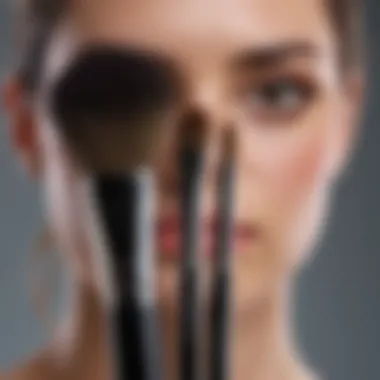
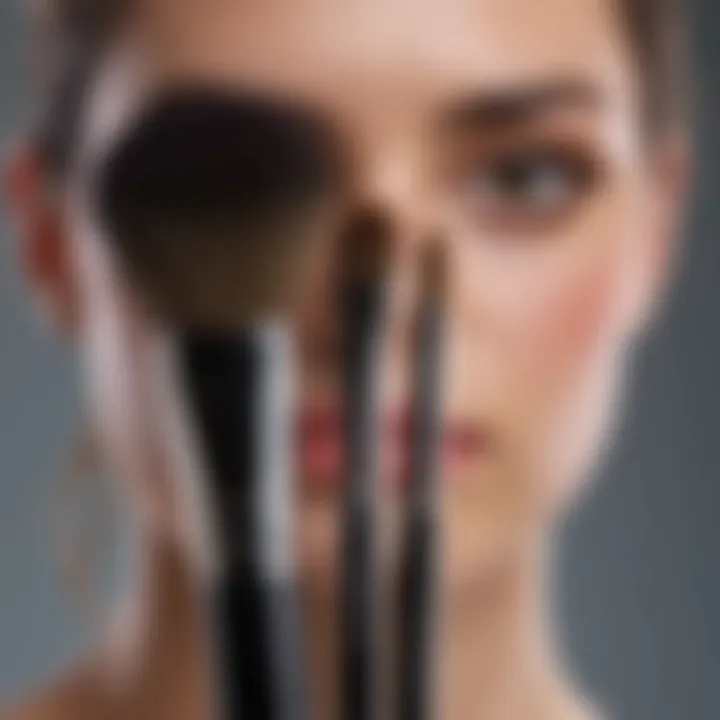
Swiping
Swiping offers a straightforward and swift option for foundation application, particularly for those in a hurry. This technique is accomplished by sweeping the brush across the skin in long strokes. What sets swiping apart is its ability to cover larger areas quickly. But tread carefully—if swiped too aggressively, this method can lead to uneven coverage or streaking, particularly around contours like the nose or jawline. It’s advisable to use this method in conjunction with others, perhaps following up with some gentle patting to finalize the look.
Circling
Circling is a bit of a hybrid technique. You make circular motions with the brush, which ensures that foundation is evenly distributed while also allowing for a built-in setting mechanism. This method is noteworthy because it can help blend foundation with minimal effort, breaking any previous lines of demarcation between skin and makeup. A potential downside is that it can sometimes lead to a heavier application than desired. Thus, if you opt for this method, gauge your pressure and speed to find the sweet spot for a flawless finish.
Layering for Desired Coverage
Layering is an essential skill in any makeup artist’s kit, and it can be critical when using liquid foundation. The technique involves building coverage gradually over areas that need extra attention without overwhelming the skin with product. When layering, it's important to allow each layer to dry slightly before adding another; this gives you better control and less chance of streaking. This method opens up opportunities to customize your foundation finish, whether you're aiming for a natural glow or more full coverage. By understanding how each layer interacts with what's already on your skin, you’ll be adept at creating a perfect canvas, tailored to your unique needs.
Maintaining Your Brushes
Maintaining your brushes is not just an afterthought; it’s an essential part of ensuring that you get the most out of your liquid foundation application. Proper brush upkeep extends the life of your tools and enhances your overall makeup experience. Dirty brushes can harbor bacteria, which may lead to skin irritations or breakouts. Moreover, when brushes are not well-maintained, they can deliver uneven application, putting a damper on the flawless finish which every makeup enthusiast craves. Thus, committing to a routine not only guarantees a well-performing brush but also contributes to healthier skin.
Regular Cleaning Routines
Keeping your brushes clean is imperative. Ideally, you should clean your foundation brushes after each use, especially if you’re using products that contain oils or creams. Start by rinsing the bristles under lukewarm water. Then, apply a gentle brush cleanser or a mild soap into the bristles. A baby shampoo can also do wonders. Gently swirl the brush in your palm or a clean cup to work the cleanser through the bristles. Rinse thoroughly until the water runs clear, which indicates that all the product is out.
Tip: To keep your brushes in top shape, ensure you’re not pressing too hard while cleaning. Over-scrubbing may harm the bristles.
Proper Drying Techniques
After cleaning, how you dry your brushes can make a world of difference. Always reshape the bristles back into their original form and lay them flat on a clean towel, preferably on a raised surface like the edge of a countertop. This prevents water from seeping into the ferrule, which is the metal part that holds the bristles in place. Allow them to air-dry completely, preferably overnight, to maintain their texture.
Signs of Wear and Tear
Brushes, like any tools, have a lifespan. Recognizing the signs of wear and tear can save you from subpar applications.
- Bristle Shedding: If you find a lot of bristles are coming out during application or cleaning, it may be time to retire that brush.
- Deformed Shape: If the bristles no longer return to their original shape after cleaning, or if they splay out excessively, that can hinder precision in application.
- Foul Odor: An unpleasant smell can mean that bacteria have built up, even after cleaning.
Check your brushes regularly and keep an eye out for these indicators as they will help you determine when it’s time to invest in new tools. In essence, a little attention to maintenance can go a long way in achieving that impeccable look while extending the life of your cherished brushes.
Final Thoughts on Brush Selection
Selecting the right brush for liquid foundation is not just about vanity; it’s a crucial step in achieving a smooth and polished look that reflects personal style and preference. The significance of this topic is multifaceted. To begin with, using the appropriate brush can transform your foundation application from a simple routine into an art form. The differences in brush types, bristle quality, and handling can greatly influence not only the final appearance but also how the foundation feels on your skin.
Personal Preferences
Navigating the world of makeup brushes can be daunting, but it's essential to recognize that personal preferences play a pivotal role in this journey. Everyone's skin is unique—some may have dry skin that benefits from a hydrating application method, while others have oily complexions better suited to matte products. When selecting a brush, think about how you like your foundation to look and feel. Do you prefer a sheer finish that lets your skin breathe, or are you aiming for full coverage?
- Consider:
- Edge of Brush: A rounded edge might feel gentle against sensitive skin, while a flat one could offer precision for more detailed areas.
- Bristle Type: Soft bristles may provide a luxurious feel, but firmer bristles can help in stippling and blending for intricate designs.
- Color: The color of the bristles can also affect how the product looks on the brush itself, impacting your perception of how it works.
Ultimately, finding a brush that aligns with your preferences will enhance both comfort and application, making your foundation routine something you look forward to.
Budget Considerations
When it comes to makeup brushes, budgeting is often a practical element that cannot be overlooked. High-end options may seem enticing, but the market is flooded with quality brushes at various price points.
- Here’s a few tips:
- Invest Wisely: Spend more on key brushes that require precision, like stippling or buffering brushes, while more basic brushes can be budget-friendly.
- Quality over Quantity: It’s better to have a few high-quality brushes than a drawer full of mediocrity.
- Read Reviews: With countless resources available, platforms like Reddit and beauty blogs can guide you towards budget-friendly yet effective options.
"The brush you choose can make the difference between a mediocre and a flawless foundation experience."
By considering personal preferences and maintaining a balanced budget, the process of selecting the optimal brush will be less about stress and more about strategy. This thoughtful approach ensures that each application leads to skin that looks artfully done, whether you are aiming for everyday wear or a night out.



